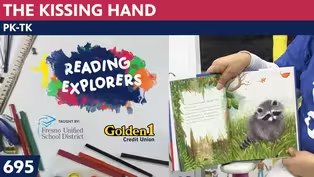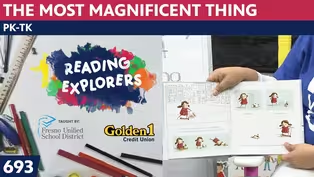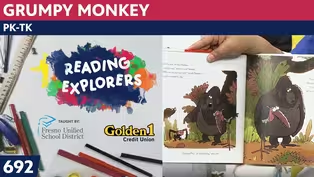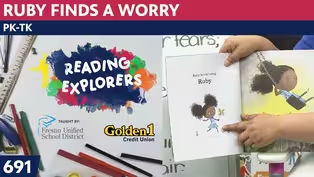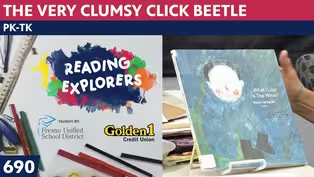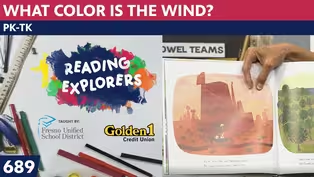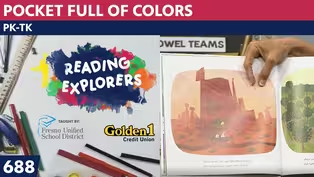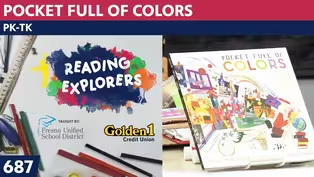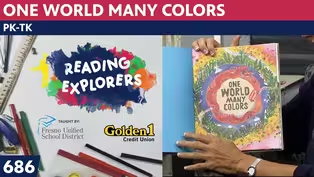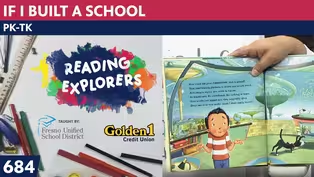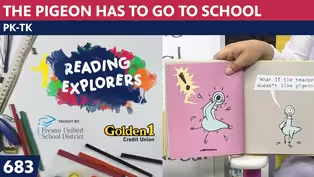
TK-348: Berthe Morisot
Season 3 Episode 264 | 14m 13sVideo has Closed Captions
Join Mrs. Readwright at Camp Discovery!
Transitional Kindergarten teacher, Mrs. Readwright, welcomes students back to Camp Discovery, a fun learning space packed with reading adventures & fun games!
Problems playing video? | Closed Captioning Feedback
Problems playing video? | Closed Captioning Feedback
Reading Explorers is a local public television program presented by Valley PBS

TK-348: Berthe Morisot
Season 3 Episode 264 | 14m 13sVideo has Closed Captions
Transitional Kindergarten teacher, Mrs. Readwright, welcomes students back to Camp Discovery, a fun learning space packed with reading adventures & fun games!
Problems playing video? | Closed Captioning Feedback
How to Watch Reading Explorers
Reading Explorers is available to stream on pbs.org and the free PBS App, available on iPhone, Apple TV, Android TV, Android smartphones, Amazon Fire TV, Amazon Fire Tablet, Roku, Samsung Smart TV, and Vizio.
Providing Support for PBS.org
Learn Moreabout PBS online sponsorshipMore from This Collection
Valley PBS and Fresno Unified School District have partnered with Golden 1 Credit Union to create Reading Explorers Lessons for grades Pre-Kindergarten through Third grade. The daily lessons will be taught by Fresno Unified School District teachers and are created to help students practice their reading skills and reinforce lessons during distance learning.
Video has Closed Captions
Valley PBS presents Reading Explorers Lessons for Pre-Kindergarten and TK. (26m 27s)
PK-TK-693-The Most Magnificent Thing
Video has Closed Captions
Valley PBS presents Reading Explorers Lessons for Pre-Kindergarten and TK. (26m 26s)
Video has Closed Captions
Valley PBS presents Reading Explorers Lessons for Pre-Kindergarten and TK. (26m 28s)
Video has Closed Captions
Valley PBS presents Reading Explorers Lessons for Pre-Kindergarten and TK. (26m 28s)
PK-TK-690: The Very Clumsy Click Beetle
Video has Closed Captions
Valley PBS presents Reading Explorers Lessons for Pre-Kindergarten and TK. (26m 22s)
PK-TK-689: What Color is the Wind?
Video has Closed Captions
Valley PBS presents Reading Explorers Lessons for Pre-Kindergarten and TK. (26m 21s)
PK-TK-688: Pocket Full of Colors
Video has Closed Captions
Valley PBS presents Reading Explorers Lessons for Pre-Kindergarten and TK. (25m 58s)
PK-TK-687: Dancing Through Fields of Colors
Video has Closed Captions
Valley PBS presents Reading Explorers Lessons for Pre-Kindergarten and TK. (26m 20s)
PK-TK-686: One World Many Colors
Video has Closed Captions
Valley PBS presents Reading Explorers Lessons for Pre-Kindergarten and TK. (27m 13s)
PK-TK-685: School is Wherever I am
Video has Closed Captions
Valley PBS presents Reading Explorers Lessons for Pre-Kindergarten and TK. (26m 32s)
PK-TK-684: If I Built a School
Video has Closed Captions
Valley PBS presents Reading Explorers Lessons for Pre-Kindergarten and TK. (26m 21s)
PK-TK-683: The Pigeon Has to Go to School
Video has Closed Captions
Valley PBS presents Reading Explorers Lessons for Pre-Kindergarten and TK. (26m 22s)
Providing Support for PBS.org
Learn Moreabout PBS online sponsorship♪ Good morning to a brand new day ♪ ♪ Time to learn and games to play ♪ ♪ Learning things is so much fun ♪ ♪ Learning is good for everyone ♪ (upbeat music) (playful music) - Hello, early learners!
It's me, Mrs. Readwright, and I'm back to welcome you to the art room, where we are doing, that's right, the ABC's of art.
And yesterday we did Q is for queen, ♪ A, B, C, D, E, F, G ♪ ♪ H, I, J, K, L, M, N, O, P ♪ ♪ Q, R ♪ Today is R, and with R, let's find out what we're going to be doing with the aid, ooh, maybe we better say the animal first.
Yesterday we sang hello from the turkey.
Oh, this is one of my favorites.
It's a chicken, or another name for it is hen.
♪ When hens get up in the morning ♪ ♪ They always say good day ♪ ♪ When hens get up in the morning ♪ ♪ They always say good day ♪ (imitates chicken) ♪ This is what they say ♪ Cluck, cluck, cluck.
♪ This is what they say ♪ And the song about the alphabet, and we'll reveal what the art is going to be by singing this, ready?
♪ A, B, C, D, E of art ♪ ♪ That's the way that we will start ♪ ♪ P is for puppet ♪ ♪ Q is for queen ♪ ♪ R is for roses that we have seen ♪ ♪ S is for sunflower, trees start with T ♪ ♪ Art and the alphabet, A, B, C ♪ And our artist today is Berthe Morisot, and she was an artist during the time, remember, way back in the day when women weren't allowed to be artists.
Their families told them, "No, you can go to school and learn about art, and you can teach art, but you can't be an artist."
But not Berthe.
Her parents said, "Be an artist," and told she and her sister, "Go, be artists," and they were.
And she met a famous artist, Manet, not Monet, like we have been teaching, but Manet, and she married Manet's brother, and he helped her get herself and her art showing, because they were listening to men in those days about the art museums, and she got to show her art.
And here is the rhyme for hers.
R is for roses.
R is for roses by Berthe Morisot.
Beautiful in a vase or in the ground where they grow.
So, this is a trio of roses, and it's in a beautiful glass vase that you can see the green in there, and you can see this big rose, a rose that's kind of facing sideways, and one that's down low.
We'll be painting some dark green and light green and highlighting with some white, and a funny thing about the paints, I usually put them into the water, but what that does is water them down and they become kind of watercolor.
And we don't always want that.
So when I use the tempera, I learned this in art school, back here, you can see where she just wiped her brush off in the background so she didn't have to use water, but I'm starting out with kind of a tan sheet of paper, and I'm going to start with the vase.
I really like to start with the flowers, because if that way the vase doesn't mix in with it.
Maybe I should, maybe I should start with the roses and draw the three roses, or you can make as many as you want, really.
It doesn't have to be the same as she, because remember when we look at art, we're just looking at it for an idea, and not to copy it.
Although we've talked about many artists did start out by copying other artists.
That's how they got good at it.
They looked at it and said, "Oh, they let their brush strokes show.
Oh, they do things in a spiral.
Well, I'll do that."
So let's see what we can do.
Let me get this up here.
Oof.
Mrs. Readwright, we've gotta build some muscles to get this table up anymore.
And I have my paper, maybe I'll put some newspaper underneath it.
I have that same one I use time after time, 'cause once it dries, it doesn't matter that I cut out a piece to put on my peaches jar.
So let me get this under here.
Let's get it set up, 'cause I have a feeling I'm going to get near the edge.
Even though I told you, I drew the black line again so I don't paint past there, so it kind of looks like a frame.
So I'm gonna set it up in a vertical fashion like I've done in the past, and I'm going to make a big rose here, a smaller rose here, and one down a little lower, like she did.
Now, I'm going to move these paints over, 'cause I want to use them, but I also have my colored pencils that I can paint with water and get those going.
I have several brushes in my jar so I can get this going here, and I also have my newspaper here, or I brought some paper towels to wash off my brush if I need to.
If I'm going between colors, just putting it at the top isn't gonna help that.
All righty.
Now, I want to dry off my brush a little bit.
And it's been sitting in here bent over for a little bit, so I want to get it.
So let's see.
I do also have a palette I can use, it's an old food container, and I like to bring this one, 'cause it's a see-through lid, and then you can see how I'm mixing my colors up.
All right, I need some white.
So I'm gonna dip that in, because when you make a tint, remember, you start with the white.
So I dip in, and I'm going to go in for a little bit of the red, so I can mix some pink, and I'm mixing the pink over here.
Let me move this so that you can see a little better.
I'm doing this pink, but I'm leaving some of the white there so that if I want to make it a little lighter, I have it.
And I also have a little bit of that red just sitting in there, so if I want to mix in it so I can use my palette.
Now, roses are little sweeps.
They're little sweeps of color.
So I'm going to go around, and look at my paintbrush.
Since it has so many different colors on it, it's showing up different colors for my roses, and I'm just making little C's, little letter C's around and around on the big one.
I go back in for a little more paint, and I want some of the darker pink to be on the outside edges, 'cause in my own garden, my roses start out with the darker part on the outside.
And then I can do some things on the middle.
I want to put a little white to mix in with the edges too so they have some shading and some tint work, and you'll see on hers.
And she doesn't ever mix all of her colors in together, and I'm going to do like she does.
So I'm gonna do this one.
Now, the sideways one is going to be down a little bit, but the same thing, I'm doing letter C around and around.
My letter C around and around.
Going around here, and it's kind of facing out.
All my letter C's are just looking so good, I'm so happy with my work.
'Cause I'm leaving my brush and the paint is kind of standing up a little bit, so it kind of looks like hers.
Now the small one over here.
The one on hers is really dark over here, like she picked one when it was just getting all of its hot pinky part.
Oh yeah, and I'm doing my C's, some forward, some backwards.
I'm gonna put a little bit of white in here and do the inside a little bit.
My paint is standing up.
It's going to be a little longer to dry, boys and girls, so don't set it in a place where it's going to run into something else.
I'm gonna keep my pink nearby, but right now I'm going to start out by putting this over here and getting a different brush so that I can start my vase.
I'm going to take my green pencil to draw what the vase looks like, and this one starts down like two.
I'm so worried that my paint is going to jump off this table.
Move over here, you.
And I'm going to see, I'm going to make it kind of curved like a cylinder.
Oh yeah, that's gonna be good.
Go down, go down, and then it has kind of a ball down here, and a ball the same shape over here.
Oh, that's good, and the bottom needs to curve, because it's a cylinder.
Now, I can put my stems coming in, and I can make some of them into leaves, and some of them are dark, and some of them are light.
So just keep adding things that you think look good, and I'm going to use my watercolor brush so that I can paint some of this green in to make this.
I'm gonna get my watercolors that I got wet already.
I told you I put a drop of water in there so that I'm able to just go straight from here, and I can paint those in.
Oh yeah, that's gonna look good, and this color is kind of what's in this vase.
Wowie, this pink paint is making it stand up.
And I can put some darker green on the edge so I can make it look rounded more.
Remember how we talked about shading things in, so that makes your vase look more round?
So I have to put the dark green and the light green to make sure that it's getting some of its round shape by mixing it in with a little more water.
Now, this green, I'm going to make it go around it like it's a rounded shape, and I can put some of the white in too, so it looks like there's water in there to keep the flowers alive.
And I'll put a little green.
Anytime it's under the edge of something else, it gets a little shadow under there, so I'm putting my little shadow there, and I can put some more water and make it go across, and I'm kind of curving it.
You notice how my brush is going curve curve, and I can do this same thing.
A shadow from the leaf has to come in, so I'm going to put a little bit on the edge and then mix it in, and some of these leaves back here might be dark green.
Not exactly happy with that straight from that petal, so I just mix it in with a lighter green, and if you don't have all these colors, you remember, mixing them up works for you.
And I can do this one here, and I like the way it's working out.
I hope you're enjoying yours too.
I have to put the table in the background.
Now, remember, we don't put the table right at the bottom of what we're working on, we put the table in a place where you can get it behind, and I'm going to mix this in so that the table has a place to be behind the vase a little bit.
Still doing it up here.
Wherever it went across, you want it to be the same height on both sides of the table.
So we want to make sure that you don't just keep putting everything underneath and have it stand like it's floating in the air.
I think this is looking pretty good, boys and girls.
I do want to add a little yellow to the middle of my flower, 'cause that's really where the pollen is, and I like the look of it.
Put a little yellow in there, and I might mix up some more colors later, but I think this is looking pretty good the way it is.
Put a little yellow in this one too.
And I'll have to paint the background, probably.
I could start it now.
It kind of had a green color on hers, but I'm gonna mix my green and my brown together, so it has an interesting background.
That's the way.
All right, boys and girls, I'm gonna set this aside so that we can sing goodbye to one another and talk about what we're going to do tomorrow.
Okay, move over, cardboard box.
All right, tomorrow is going to be letter S, and letter S is for sunflowers, and we're gonna make a bouquet of sunflowers, so white paper and tempera, brushes, water, scissors.
Yellow tissue paper is going to make it look like it has real petals on it.
♪ So it's time to say goodbye to all my friends ♪ ♪ Oh, it's time to say goodbye to all my friends ♪ ♪ Oh, it's time to say goodbye ♪ Bye, boys and girls.
I'll see you tomorrow.
Thanks for joining me.
(upbeat music) ♪ Good morning to a brand new day ♪ ♪ Time to learn and games to play ♪ ♪ Learning things is so much fun ♪ ♪ Learning is good for everyone ♪ (upbeat music)
Support for PBS provided by:
Reading Explorers is a local public television program presented by Valley PBS
